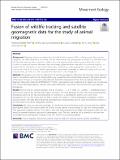Files in this item
Fusion of wildlife tracking and satellite geomagnetic data for the study of animal migration
Item metadata
| dc.contributor.author | Benitez Paez, Manuel Fernando | |
| dc.contributor.author | Brum-Bastos, Vanessa | |
| dc.contributor.author | Beggan , Ciarán | |
| dc.contributor.author | Long, Jed | |
| dc.contributor.author | Demsar, Urska | |
| dc.date.accessioned | 2021-06-15T09:05:37Z | |
| dc.date.available | 2021-06-15T09:05:37Z | |
| dc.date.issued | 2021-06-11 | |
| dc.identifier | 274437769 | |
| dc.identifier | f10596c5-9e30-4d3a-8c4a-3b6ee40400de | |
| dc.identifier | 85107751437 | |
| dc.identifier | 000663801400003 | |
| dc.identifier.citation | Benitez Paez , M F , Brum-Bastos , V , Beggan , C , Long , J & Demsar , U 2021 , ' Fusion of wildlife tracking and satellite geomagnetic data for the study of animal migration ' , Movement Ecology , vol. 9 , 31 . https://doi.org/10.1186/s40462-021-00268-4 | en |
| dc.identifier.issn | 2051-3933 | |
| dc.identifier.other | ORCID: /0000-0001-7791-2807/work/95772521 | |
| dc.identifier.other | ORCID: /0000-0002-5865-0204/work/95772593 | |
| dc.identifier.other | ORCID: /0000-0002-9884-6471/work/95772847 | |
| dc.identifier.uri | https://hdl.handle.net/10023/23359 | |
| dc.description | This work was supported by the Leverhulme Trust [Research Project Grant RPG-2018-258]. | en |
| dc.description.abstract | Background: Migratory animals use information from the Earth’s magnetic field on their journeys. Geomagnetic navigation has been observed across many taxa, but how animals use geomagnetic information to find their way is still relatively unknown. Most migration studies use a static representation of geomagnetic field and do not consider its temporal variation. However, short-term temporal perturbations may affect how animals respond - to understand this phenomenon, we need to obtain fine resolution accurate geomagnetic measurements at the location and time of the animal. Satellite geomagnetic measurements provide a potential to create such accurate measurements, yet have not been used yet for exploration of animal migration. Methods: We develop a new tool for data fusion of satellite geomagnetic data (from the European Space Agency’s Swarm constellation) with animal tracking data using a spatio-temporal interpolation approach. We assess accuracy of the fusion through a comparison with calibrated terrestrial measurements from the International Real-time Magnetic Observatory Network (INTERMAGNET). We fit a generalized linear model (GLM) to assess how the absolute error of annotated geomagnetic intensity varies with interpolation parameters and with the local geomagnetic disturbance. Results: We find that the average absolute error of intensity is − 21.6 nT (95% CI [− 22.26555, − 20.96664]), which is at the lower range of the intensity that animals can sense. The main predictor of error is the level of geomagnetic disturbance, given by the Kp index (indicating the presence of a geomagnetic storm). Since storm level disturbances are rare, this means that our tool is suitable for studies of animal geomagnetic navigation. Caution should be taken with data obtained during geomagnetically disturbed days due to rapid and localised changes of the field which may not be adequately captured. Conclusions: By using our new tool, ecologists will be able to, for the first time, access accurate real-time satellite geomagnetic data at the location and time of each tracked animal, without having to start new tracking studies with specialised magnetic sensors. This opens a new and exciting possibility for large multi-species studies that will search for general migratory responses to geomagnetic cues. The tool therefore has a potential to uncover new knowledge about geomagnetic navigation and help resolve long-standing debates. | |
| dc.format.extent | 19 | |
| dc.format.extent | 4085552 | |
| dc.language.iso | eng | |
| dc.relation.ispartof | Movement Ecology | en |
| dc.subject | Animal migration | en |
| dc.subject | Data fusion | en |
| dc.subject | Earth's magnetic field | en |
| dc.subject | GPS tracking | en |
| dc.subject | Swarm satellite constellation | en |
| dc.subject | QH301 Biology | en |
| dc.subject | DAS | en |
| dc.subject.lcc | QH301 | en |
| dc.title | Fusion of wildlife tracking and satellite geomagnetic data for the study of animal migration | en |
| dc.type | Journal article | en |
| dc.contributor.sponsor | The Leverhulme Trust | en |
| dc.contributor.institution | University of St Andrews. School of Geography & Sustainable Development | en |
| dc.contributor.institution | University of St Andrews. Bell-Edwards Geographic Data Institute | en |
| dc.identifier.doi | 10.1186/s40462-021-00268-4 | |
| dc.description.status | Peer reviewed | en |
| dc.identifier.grantnumber | RPG-2018-258 | en |
This item appears in the following Collection(s)
Items in the St Andrews Research Repository are protected by copyright, with all rights reserved, unless otherwise indicated.

